Tax Implications: Sophie, Kate, Joe - Beauty Clinic Case
VerifiedAdded on 2022/12/13
|13
|3808
|232
Homework Assignment
AI Summary
This assignment delves into the tax implications for three individuals: Sophie Jones, Kate, and Joe, arising from a case involving a faulty laser machine in a beauty clinic. The analysis examines the tax consequences of various financial transactions, including compensation for reputational loss, income loss, and legal fees for Sophie. For Kate, the assignment assesses the tax implications of lump-sum payments for pain and suffering, ongoing medical and cosmetic surgery costs, and interest received. The assignment also considers the tax consequences for Joe. The assignment applies relevant tax principles, including those related to Capital Gains Tax (CGT), ordinary income, and reimbursements, referencing legal precedents to support the conclusions. The analysis highlights the importance of understanding tax regulations in different scenarios and how compensation and reimbursements are treated for tax purposes, offering insights into the application of tax law in practical situations and identifying the taxability of different types of income and expenses.
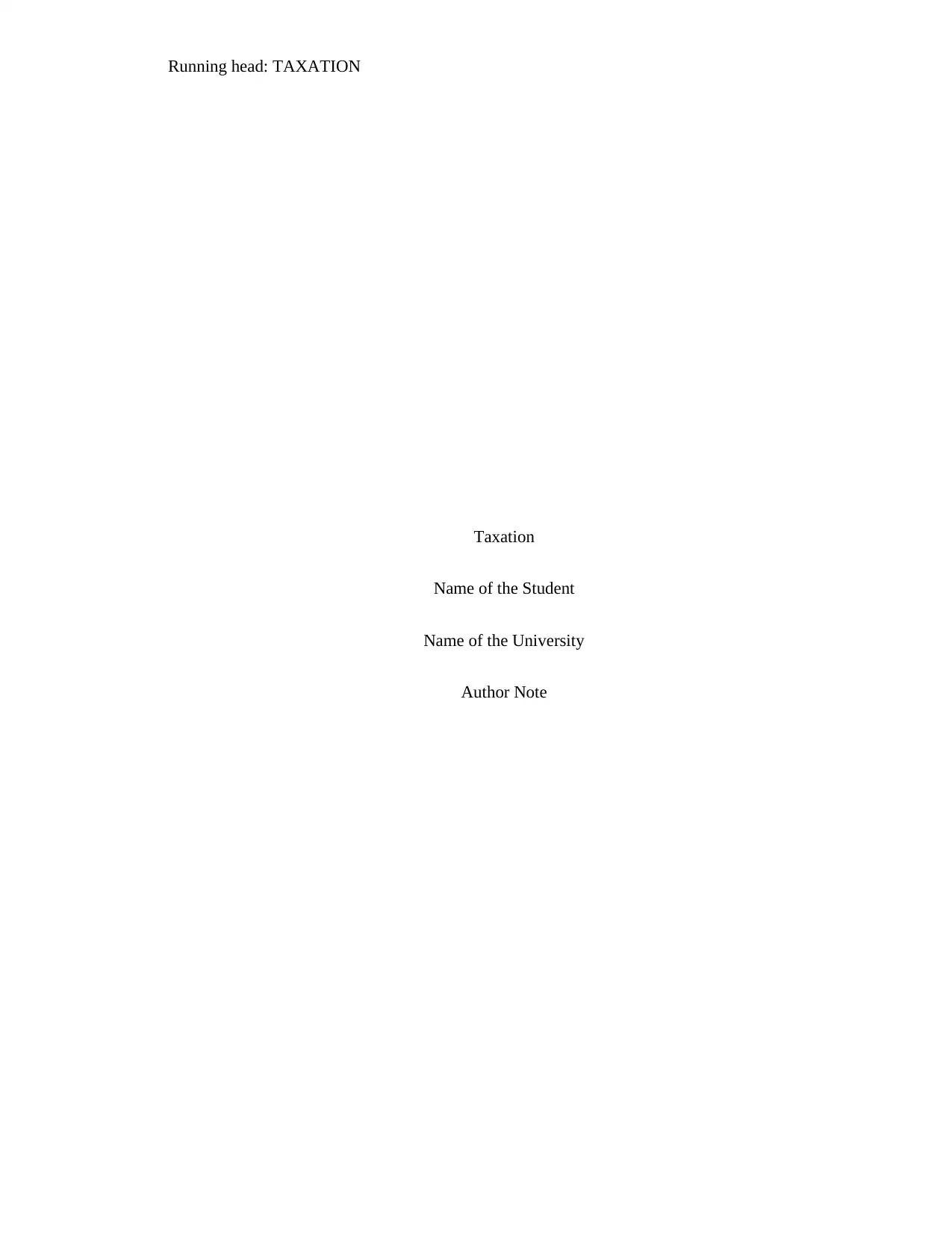
Running head: TAXATION
Taxation
Name of the Student
Name of the University
Author Note
Taxation
Name of the Student
Name of the University
Author Note
Paraphrase This Document
Need a fresh take? Get an instant paraphrase of this document with our AI Paraphraser
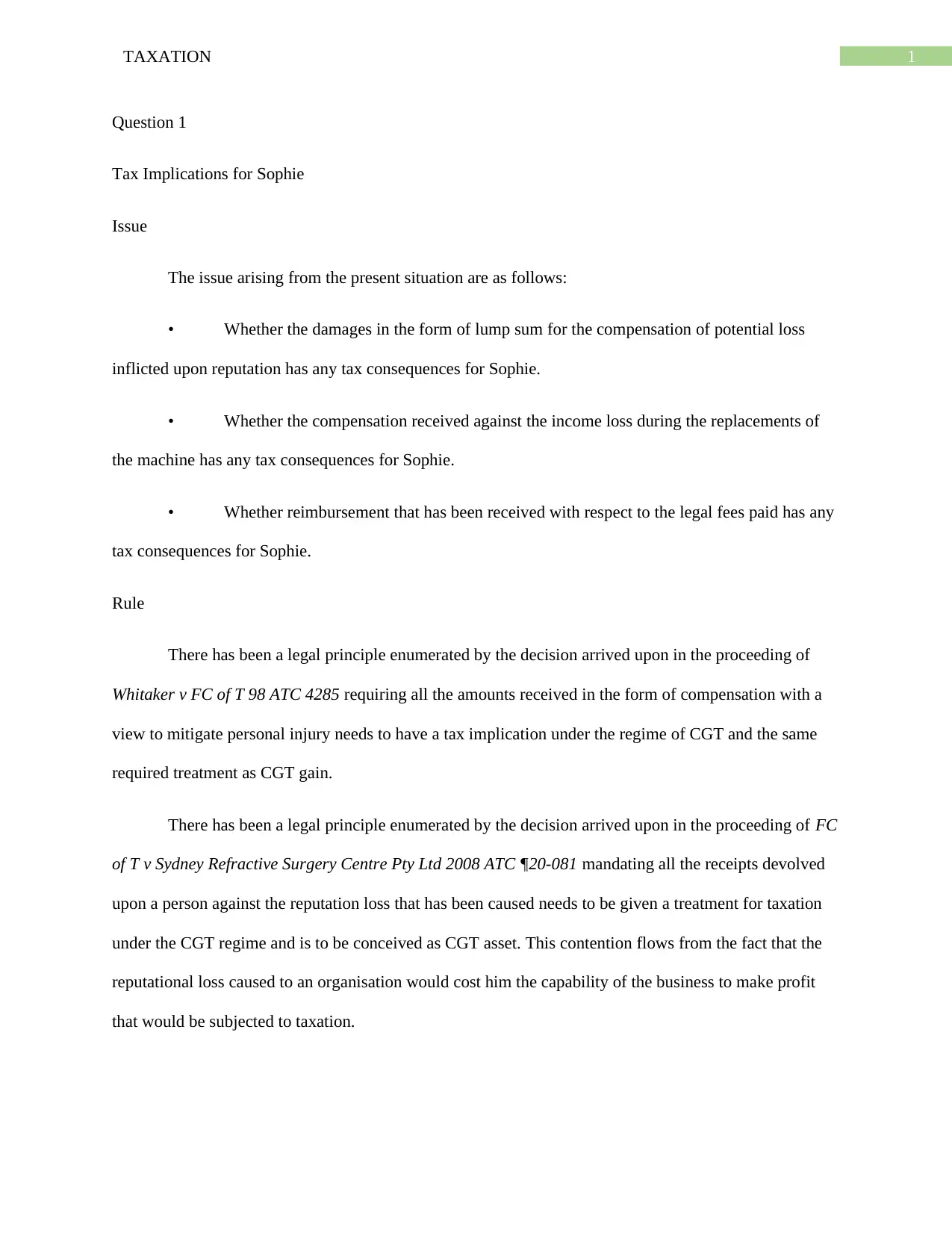
1TAXATION
Question 1
Tax Implications for Sophie
Issue
The issue arising from the present situation are as follows:
• Whether the damages in the form of lump sum for the compensation of potential loss
inflicted upon reputation has any tax consequences for Sophie.
• Whether the compensation received against the income loss during the replacements of
the machine has any tax consequences for Sophie.
• Whether reimbursement that has been received with respect to the legal fees paid has any
tax consequences for Sophie.
Rule
There has been a legal principle enumerated by the decision arrived upon in the proceeding of
Whitaker v FC of T 98 ATC 4285 requiring all the amounts received in the form of compensation with a
view to mitigate personal injury needs to have a tax implication under the regime of CGT and the same
required treatment as CGT gain.
There has been a legal principle enumerated by the decision arrived upon in the proceeding of FC
of T v Sydney Refractive Surgery Centre Pty Ltd 2008 ATC ¶20-081 mandating all the receipts devolved
upon a person against the reputation loss that has been caused needs to be given a treatment for taxation
under the CGT regime and is to be conceived as CGT asset. This contention flows from the fact that the
reputational loss caused to an organisation would cost him the capability of the business to make profit
that would be subjected to taxation.
Question 1
Tax Implications for Sophie
Issue
The issue arising from the present situation are as follows:
• Whether the damages in the form of lump sum for the compensation of potential loss
inflicted upon reputation has any tax consequences for Sophie.
• Whether the compensation received against the income loss during the replacements of
the machine has any tax consequences for Sophie.
• Whether reimbursement that has been received with respect to the legal fees paid has any
tax consequences for Sophie.
Rule
There has been a legal principle enumerated by the decision arrived upon in the proceeding of
Whitaker v FC of T 98 ATC 4285 requiring all the amounts received in the form of compensation with a
view to mitigate personal injury needs to have a tax implication under the regime of CGT and the same
required treatment as CGT gain.
There has been a legal principle enumerated by the decision arrived upon in the proceeding of FC
of T v Sydney Refractive Surgery Centre Pty Ltd 2008 ATC ¶20-081 mandating all the receipts devolved
upon a person against the reputation loss that has been caused needs to be given a treatment for taxation
under the CGT regime and is to be conceived as CGT asset. This contention flows from the fact that the
reputational loss caused to an organisation would cost him the capability of the business to make profit
that would be subjected to taxation.
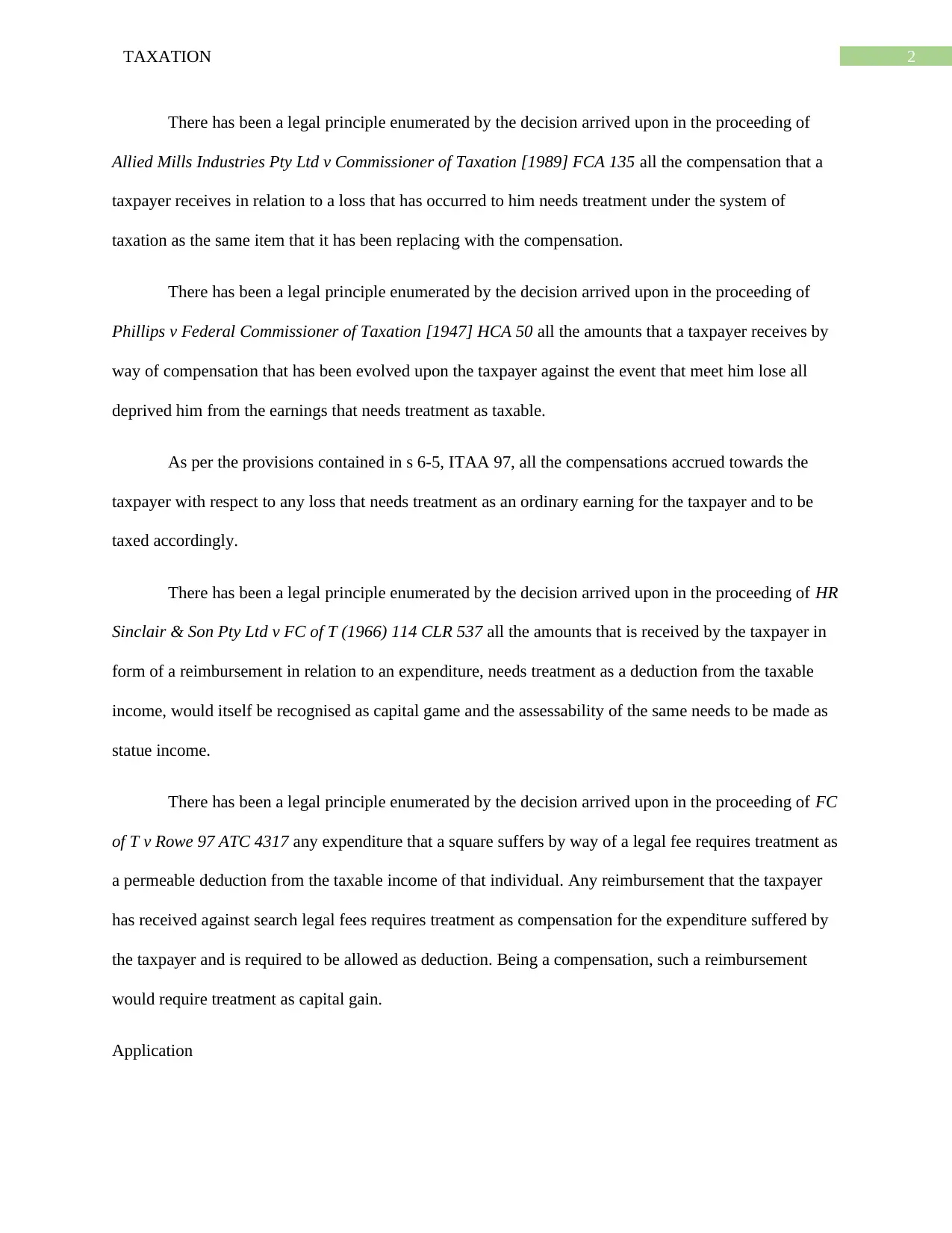
2TAXATION
There has been a legal principle enumerated by the decision arrived upon in the proceeding of
Allied Mills Industries Pty Ltd v Commissioner of Taxation [1989] FCA 135 all the compensation that a
taxpayer receives in relation to a loss that has occurred to him needs treatment under the system of
taxation as the same item that it has been replacing with the compensation.
There has been a legal principle enumerated by the decision arrived upon in the proceeding of
Phillips v Federal Commissioner of Taxation [1947] HCA 50 all the amounts that a taxpayer receives by
way of compensation that has been evolved upon the taxpayer against the event that meet him lose all
deprived him from the earnings that needs treatment as taxable.
As per the provisions contained in s 6-5, ITAA 97, all the compensations accrued towards the
taxpayer with respect to any loss that needs treatment as an ordinary earning for the taxpayer and to be
taxed accordingly.
There has been a legal principle enumerated by the decision arrived upon in the proceeding of HR
Sinclair & Son Pty Ltd v FC of T (1966) 114 CLR 537 all the amounts that is received by the taxpayer in
form of a reimbursement in relation to an expenditure, needs treatment as a deduction from the taxable
income, would itself be recognised as capital game and the assessability of the same needs to be made as
statue income.
There has been a legal principle enumerated by the decision arrived upon in the proceeding of FC
of T v Rowe 97 ATC 4317 any expenditure that a square suffers by way of a legal fee requires treatment as
a permeable deduction from the taxable income of that individual. Any reimbursement that the taxpayer
has received against search legal fees requires treatment as compensation for the expenditure suffered by
the taxpayer and is required to be allowed as deduction. Being a compensation, such a reimbursement
would require treatment as capital gain.
Application
There has been a legal principle enumerated by the decision arrived upon in the proceeding of
Allied Mills Industries Pty Ltd v Commissioner of Taxation [1989] FCA 135 all the compensation that a
taxpayer receives in relation to a loss that has occurred to him needs treatment under the system of
taxation as the same item that it has been replacing with the compensation.
There has been a legal principle enumerated by the decision arrived upon in the proceeding of
Phillips v Federal Commissioner of Taxation [1947] HCA 50 all the amounts that a taxpayer receives by
way of compensation that has been evolved upon the taxpayer against the event that meet him lose all
deprived him from the earnings that needs treatment as taxable.
As per the provisions contained in s 6-5, ITAA 97, all the compensations accrued towards the
taxpayer with respect to any loss that needs treatment as an ordinary earning for the taxpayer and to be
taxed accordingly.
There has been a legal principle enumerated by the decision arrived upon in the proceeding of HR
Sinclair & Son Pty Ltd v FC of T (1966) 114 CLR 537 all the amounts that is received by the taxpayer in
form of a reimbursement in relation to an expenditure, needs treatment as a deduction from the taxable
income, would itself be recognised as capital game and the assessability of the same needs to be made as
statue income.
There has been a legal principle enumerated by the decision arrived upon in the proceeding of FC
of T v Rowe 97 ATC 4317 any expenditure that a square suffers by way of a legal fee requires treatment as
a permeable deduction from the taxable income of that individual. Any reimbursement that the taxpayer
has received against search legal fees requires treatment as compensation for the expenditure suffered by
the taxpayer and is required to be allowed as deduction. Being a compensation, such a reimbursement
would require treatment as capital gain.
Application
⊘ This is a preview!⊘
Do you want full access?
Subscribe today to unlock all pages.

Trusted by 1+ million students worldwide
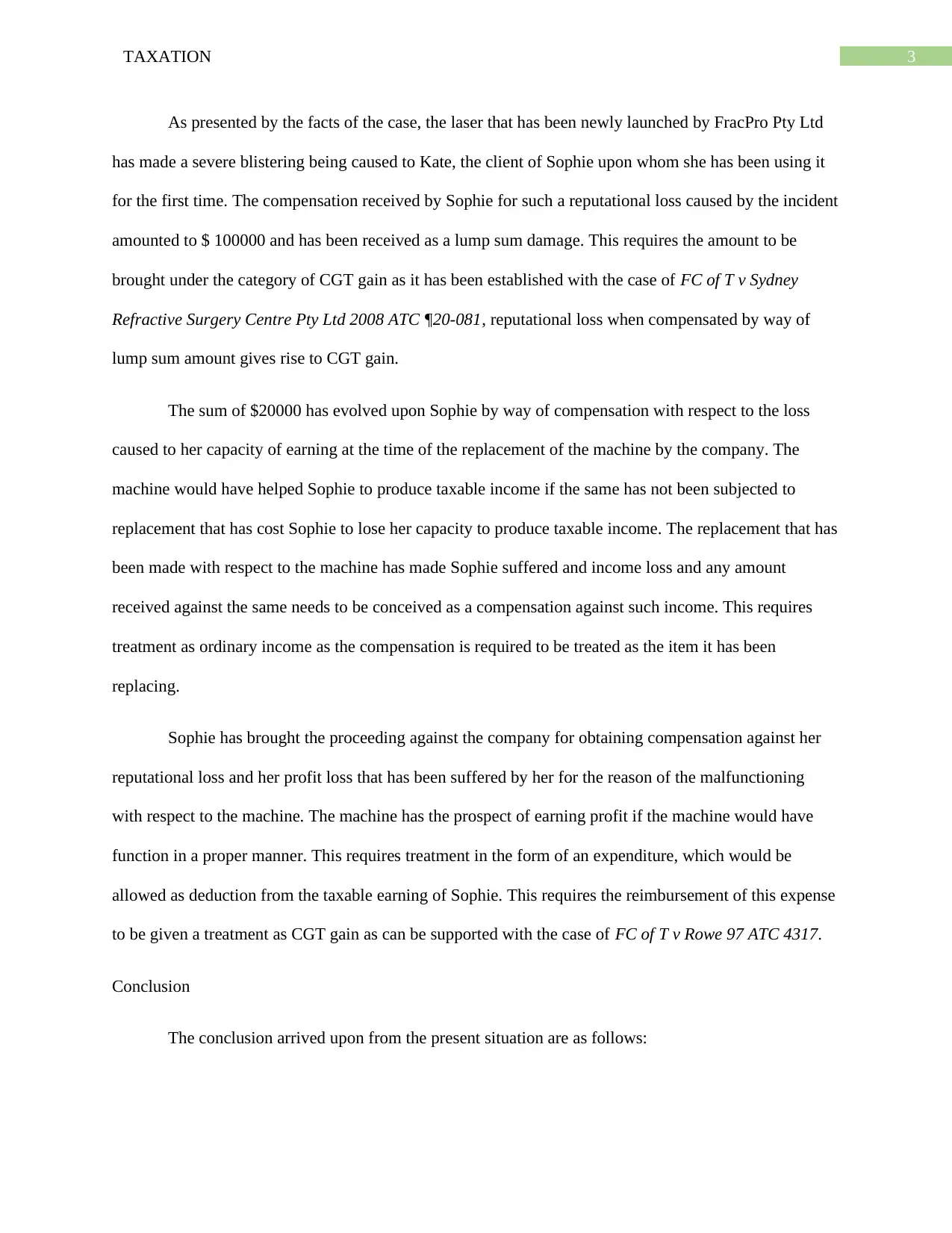
3TAXATION
As presented by the facts of the case, the laser that has been newly launched by FracPro Pty Ltd
has made a severe blistering being caused to Kate, the client of Sophie upon whom she has been using it
for the first time. The compensation received by Sophie for such a reputational loss caused by the incident
amounted to $ 100000 and has been received as a lump sum damage. This requires the amount to be
brought under the category of CGT gain as it has been established with the case of FC of T v Sydney
Refractive Surgery Centre Pty Ltd 2008 ATC ¶20-081, reputational loss when compensated by way of
lump sum amount gives rise to CGT gain.
The sum of $20000 has evolved upon Sophie by way of compensation with respect to the loss
caused to her capacity of earning at the time of the replacement of the machine by the company. The
machine would have helped Sophie to produce taxable income if the same has not been subjected to
replacement that has cost Sophie to lose her capacity to produce taxable income. The replacement that has
been made with respect to the machine has made Sophie suffered and income loss and any amount
received against the same needs to be conceived as a compensation against such income. This requires
treatment as ordinary income as the compensation is required to be treated as the item it has been
replacing.
Sophie has brought the proceeding against the company for obtaining compensation against her
reputational loss and her profit loss that has been suffered by her for the reason of the malfunctioning
with respect to the machine. The machine has the prospect of earning profit if the machine would have
function in a proper manner. This requires treatment in the form of an expenditure, which would be
allowed as deduction from the taxable earning of Sophie. This requires the reimbursement of this expense
to be given a treatment as CGT gain as can be supported with the case of FC of T v Rowe 97 ATC 4317.
Conclusion
The conclusion arrived upon from the present situation are as follows:
As presented by the facts of the case, the laser that has been newly launched by FracPro Pty Ltd
has made a severe blistering being caused to Kate, the client of Sophie upon whom she has been using it
for the first time. The compensation received by Sophie for such a reputational loss caused by the incident
amounted to $ 100000 and has been received as a lump sum damage. This requires the amount to be
brought under the category of CGT gain as it has been established with the case of FC of T v Sydney
Refractive Surgery Centre Pty Ltd 2008 ATC ¶20-081, reputational loss when compensated by way of
lump sum amount gives rise to CGT gain.
The sum of $20000 has evolved upon Sophie by way of compensation with respect to the loss
caused to her capacity of earning at the time of the replacement of the machine by the company. The
machine would have helped Sophie to produce taxable income if the same has not been subjected to
replacement that has cost Sophie to lose her capacity to produce taxable income. The replacement that has
been made with respect to the machine has made Sophie suffered and income loss and any amount
received against the same needs to be conceived as a compensation against such income. This requires
treatment as ordinary income as the compensation is required to be treated as the item it has been
replacing.
Sophie has brought the proceeding against the company for obtaining compensation against her
reputational loss and her profit loss that has been suffered by her for the reason of the malfunctioning
with respect to the machine. The machine has the prospect of earning profit if the machine would have
function in a proper manner. This requires treatment in the form of an expenditure, which would be
allowed as deduction from the taxable earning of Sophie. This requires the reimbursement of this expense
to be given a treatment as CGT gain as can be supported with the case of FC of T v Rowe 97 ATC 4317.
Conclusion
The conclusion arrived upon from the present situation are as follows:
Paraphrase This Document
Need a fresh take? Get an instant paraphrase of this document with our AI Paraphraser
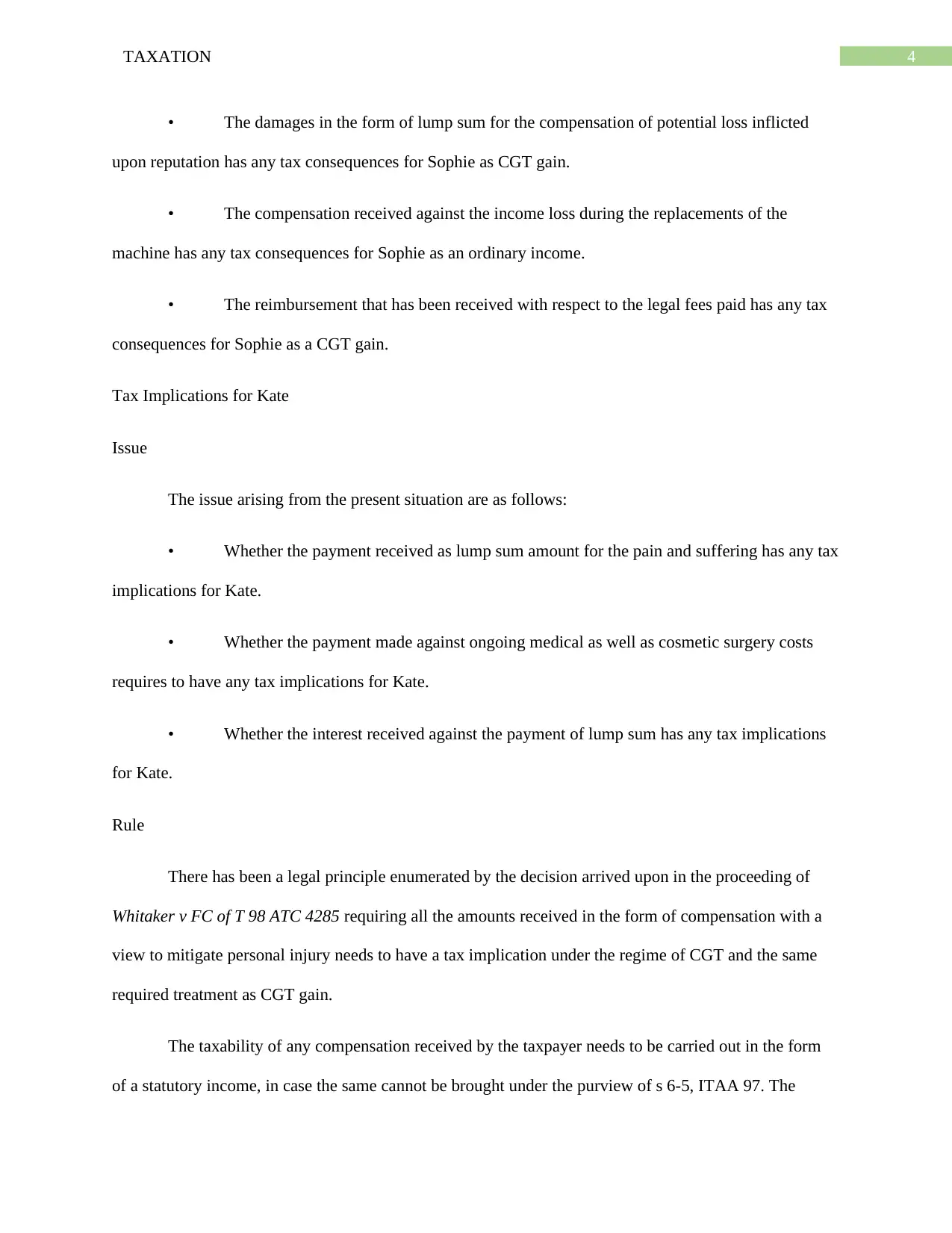
4TAXATION
• The damages in the form of lump sum for the compensation of potential loss inflicted
upon reputation has any tax consequences for Sophie as CGT gain.
• The compensation received against the income loss during the replacements of the
machine has any tax consequences for Sophie as an ordinary income.
• The reimbursement that has been received with respect to the legal fees paid has any tax
consequences for Sophie as a CGT gain.
Tax Implications for Kate
Issue
The issue arising from the present situation are as follows:
• Whether the payment received as lump sum amount for the pain and suffering has any tax
implications for Kate.
• Whether the payment made against ongoing medical as well as cosmetic surgery costs
requires to have any tax implications for Kate.
• Whether the interest received against the payment of lump sum has any tax implications
for Kate.
Rule
There has been a legal principle enumerated by the decision arrived upon in the proceeding of
Whitaker v FC of T 98 ATC 4285 requiring all the amounts received in the form of compensation with a
view to mitigate personal injury needs to have a tax implication under the regime of CGT and the same
required treatment as CGT gain.
The taxability of any compensation received by the taxpayer needs to be carried out in the form
of a statutory income, in case the same cannot be brought under the purview of s 6-5, ITAA 97. The
• The damages in the form of lump sum for the compensation of potential loss inflicted
upon reputation has any tax consequences for Sophie as CGT gain.
• The compensation received against the income loss during the replacements of the
machine has any tax consequences for Sophie as an ordinary income.
• The reimbursement that has been received with respect to the legal fees paid has any tax
consequences for Sophie as a CGT gain.
Tax Implications for Kate
Issue
The issue arising from the present situation are as follows:
• Whether the payment received as lump sum amount for the pain and suffering has any tax
implications for Kate.
• Whether the payment made against ongoing medical as well as cosmetic surgery costs
requires to have any tax implications for Kate.
• Whether the interest received against the payment of lump sum has any tax implications
for Kate.
Rule
There has been a legal principle enumerated by the decision arrived upon in the proceeding of
Whitaker v FC of T 98 ATC 4285 requiring all the amounts received in the form of compensation with a
view to mitigate personal injury needs to have a tax implication under the regime of CGT and the same
required treatment as CGT gain.
The taxability of any compensation received by the taxpayer needs to be carried out in the form
of a statutory income, in case the same cannot be brought under the purview of s 6-5, ITAA 97. The
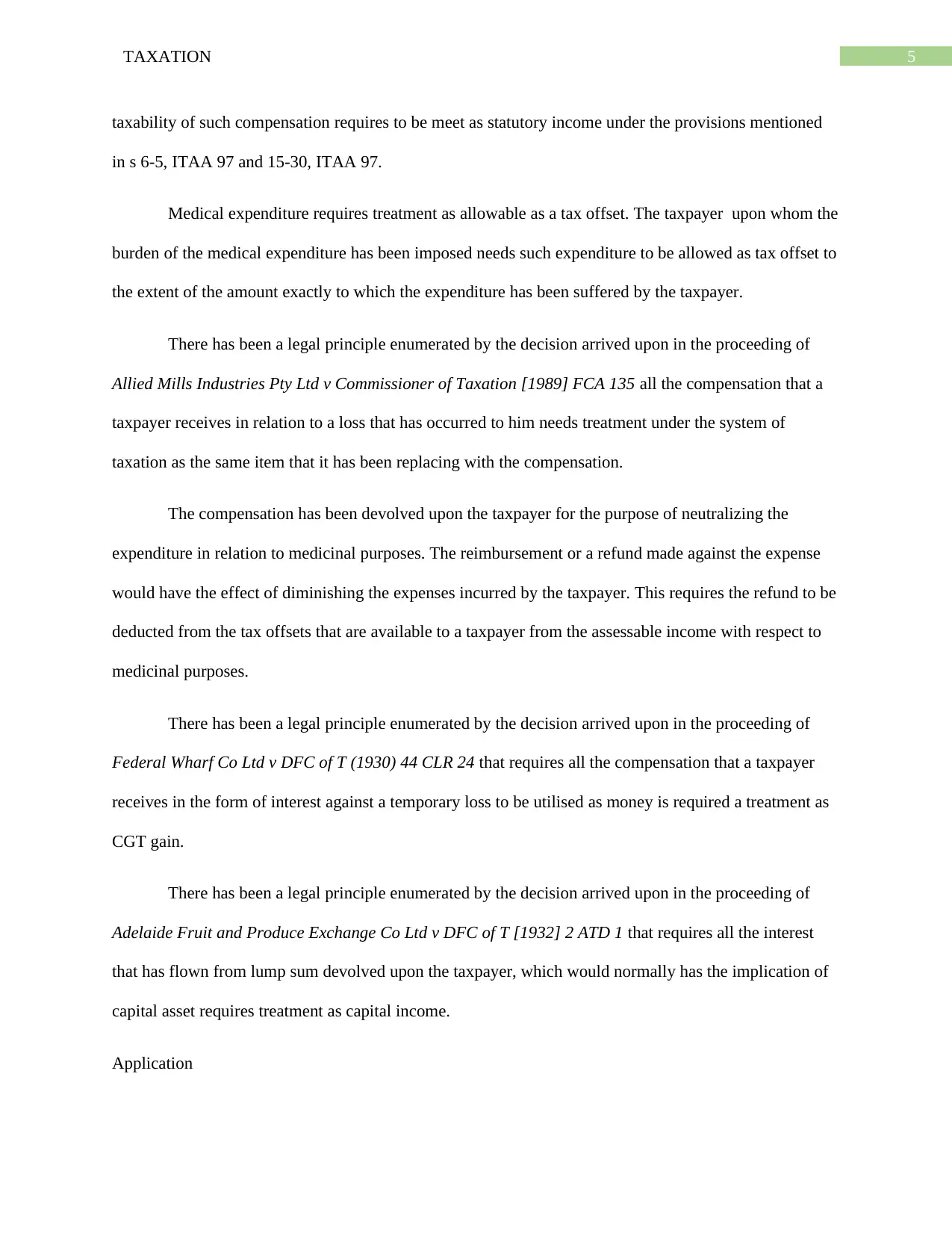
5TAXATION
taxability of such compensation requires to be meet as statutory income under the provisions mentioned
in s 6-5, ITAA 97 and 15-30, ITAA 97.
Medical expenditure requires treatment as allowable as a tax offset. The taxpayer upon whom the
burden of the medical expenditure has been imposed needs such expenditure to be allowed as tax offset to
the extent of the amount exactly to which the expenditure has been suffered by the taxpayer.
There has been a legal principle enumerated by the decision arrived upon in the proceeding of
Allied Mills Industries Pty Ltd v Commissioner of Taxation [1989] FCA 135 all the compensation that a
taxpayer receives in relation to a loss that has occurred to him needs treatment under the system of
taxation as the same item that it has been replacing with the compensation.
The compensation has been devolved upon the taxpayer for the purpose of neutralizing the
expenditure in relation to medicinal purposes. The reimbursement or a refund made against the expense
would have the effect of diminishing the expenses incurred by the taxpayer. This requires the refund to be
deducted from the tax offsets that are available to a taxpayer from the assessable income with respect to
medicinal purposes.
There has been a legal principle enumerated by the decision arrived upon in the proceeding of
Federal Wharf Co Ltd v DFC of T (1930) 44 CLR 24 that requires all the compensation that a taxpayer
receives in the form of interest against a temporary loss to be utilised as money is required a treatment as
CGT gain.
There has been a legal principle enumerated by the decision arrived upon in the proceeding of
Adelaide Fruit and Produce Exchange Co Ltd v DFC of T [1932] 2 ATD 1 that requires all the interest
that has flown from lump sum devolved upon the taxpayer, which would normally has the implication of
capital asset requires treatment as capital income.
Application
taxability of such compensation requires to be meet as statutory income under the provisions mentioned
in s 6-5, ITAA 97 and 15-30, ITAA 97.
Medical expenditure requires treatment as allowable as a tax offset. The taxpayer upon whom the
burden of the medical expenditure has been imposed needs such expenditure to be allowed as tax offset to
the extent of the amount exactly to which the expenditure has been suffered by the taxpayer.
There has been a legal principle enumerated by the decision arrived upon in the proceeding of
Allied Mills Industries Pty Ltd v Commissioner of Taxation [1989] FCA 135 all the compensation that a
taxpayer receives in relation to a loss that has occurred to him needs treatment under the system of
taxation as the same item that it has been replacing with the compensation.
The compensation has been devolved upon the taxpayer for the purpose of neutralizing the
expenditure in relation to medicinal purposes. The reimbursement or a refund made against the expense
would have the effect of diminishing the expenses incurred by the taxpayer. This requires the refund to be
deducted from the tax offsets that are available to a taxpayer from the assessable income with respect to
medicinal purposes.
There has been a legal principle enumerated by the decision arrived upon in the proceeding of
Federal Wharf Co Ltd v DFC of T (1930) 44 CLR 24 that requires all the compensation that a taxpayer
receives in the form of interest against a temporary loss to be utilised as money is required a treatment as
CGT gain.
There has been a legal principle enumerated by the decision arrived upon in the proceeding of
Adelaide Fruit and Produce Exchange Co Ltd v DFC of T [1932] 2 ATD 1 that requires all the interest
that has flown from lump sum devolved upon the taxpayer, which would normally has the implication of
capital asset requires treatment as capital income.
Application
⊘ This is a preview!⊘
Do you want full access?
Subscribe today to unlock all pages.

Trusted by 1+ million students worldwide
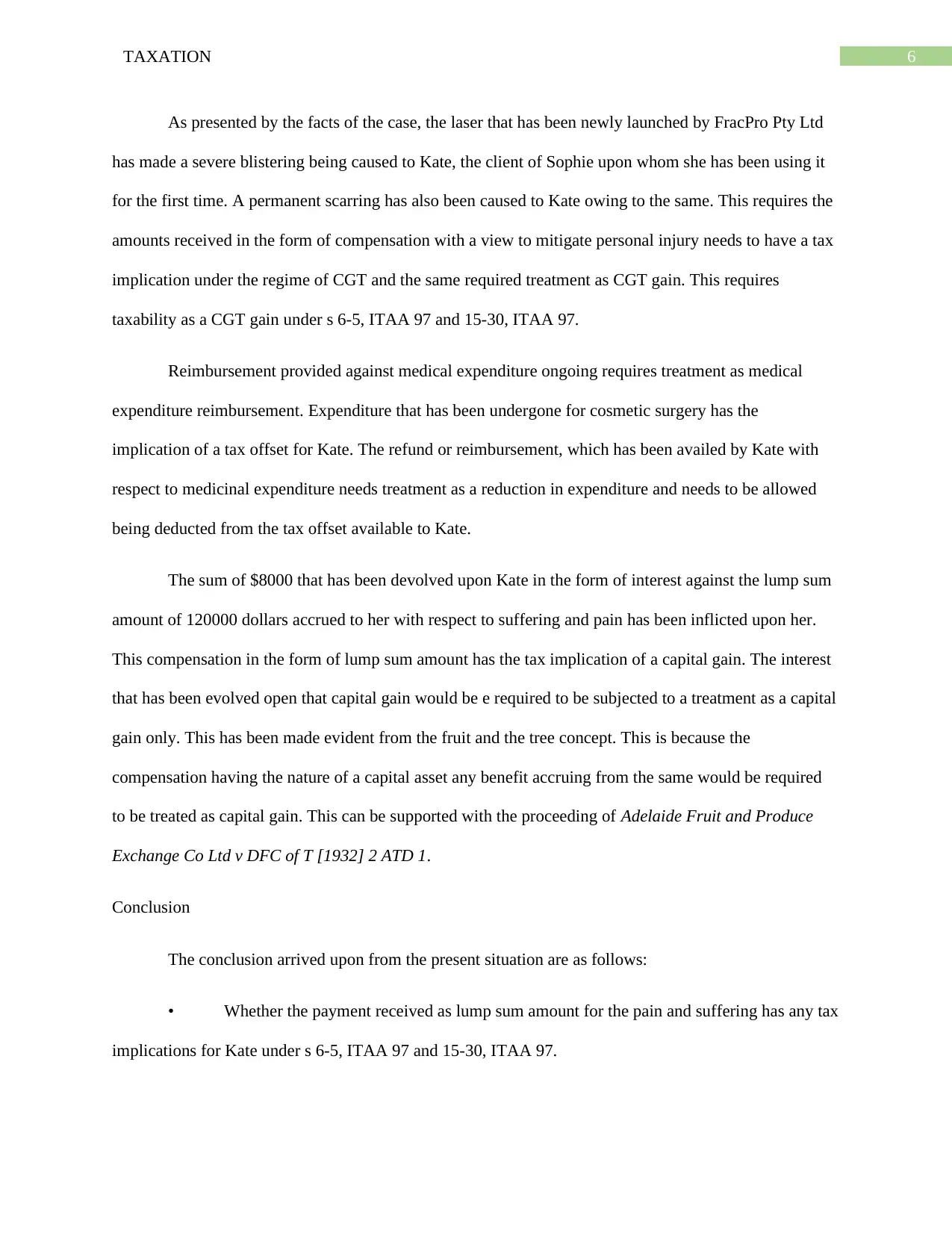
6TAXATION
As presented by the facts of the case, the laser that has been newly launched by FracPro Pty Ltd
has made a severe blistering being caused to Kate, the client of Sophie upon whom she has been using it
for the first time. A permanent scarring has also been caused to Kate owing to the same. This requires the
amounts received in the form of compensation with a view to mitigate personal injury needs to have a tax
implication under the regime of CGT and the same required treatment as CGT gain. This requires
taxability as a CGT gain under s 6-5, ITAA 97 and 15-30, ITAA 97.
Reimbursement provided against medical expenditure ongoing requires treatment as medical
expenditure reimbursement. Expenditure that has been undergone for cosmetic surgery has the
implication of a tax offset for Kate. The refund or reimbursement, which has been availed by Kate with
respect to medicinal expenditure needs treatment as a reduction in expenditure and needs to be allowed
being deducted from the tax offset available to Kate.
The sum of $8000 that has been devolved upon Kate in the form of interest against the lump sum
amount of 120000 dollars accrued to her with respect to suffering and pain has been inflicted upon her.
This compensation in the form of lump sum amount has the tax implication of a capital gain. The interest
that has been evolved open that capital gain would be e required to be subjected to a treatment as a capital
gain only. This has been made evident from the fruit and the tree concept. This is because the
compensation having the nature of a capital asset any benefit accruing from the same would be required
to be treated as capital gain. This can be supported with the proceeding of Adelaide Fruit and Produce
Exchange Co Ltd v DFC of T [1932] 2 ATD 1.
Conclusion
The conclusion arrived upon from the present situation are as follows:
• Whether the payment received as lump sum amount for the pain and suffering has any tax
implications for Kate under s 6-5, ITAA 97 and 15-30, ITAA 97.
As presented by the facts of the case, the laser that has been newly launched by FracPro Pty Ltd
has made a severe blistering being caused to Kate, the client of Sophie upon whom she has been using it
for the first time. A permanent scarring has also been caused to Kate owing to the same. This requires the
amounts received in the form of compensation with a view to mitigate personal injury needs to have a tax
implication under the regime of CGT and the same required treatment as CGT gain. This requires
taxability as a CGT gain under s 6-5, ITAA 97 and 15-30, ITAA 97.
Reimbursement provided against medical expenditure ongoing requires treatment as medical
expenditure reimbursement. Expenditure that has been undergone for cosmetic surgery has the
implication of a tax offset for Kate. The refund or reimbursement, which has been availed by Kate with
respect to medicinal expenditure needs treatment as a reduction in expenditure and needs to be allowed
being deducted from the tax offset available to Kate.
The sum of $8000 that has been devolved upon Kate in the form of interest against the lump sum
amount of 120000 dollars accrued to her with respect to suffering and pain has been inflicted upon her.
This compensation in the form of lump sum amount has the tax implication of a capital gain. The interest
that has been evolved open that capital gain would be e required to be subjected to a treatment as a capital
gain only. This has been made evident from the fruit and the tree concept. This is because the
compensation having the nature of a capital asset any benefit accruing from the same would be required
to be treated as capital gain. This can be supported with the proceeding of Adelaide Fruit and Produce
Exchange Co Ltd v DFC of T [1932] 2 ATD 1.
Conclusion
The conclusion arrived upon from the present situation are as follows:
• Whether the payment received as lump sum amount for the pain and suffering has any tax
implications for Kate under s 6-5, ITAA 97 and 15-30, ITAA 97.
Paraphrase This Document
Need a fresh take? Get an instant paraphrase of this document with our AI Paraphraser
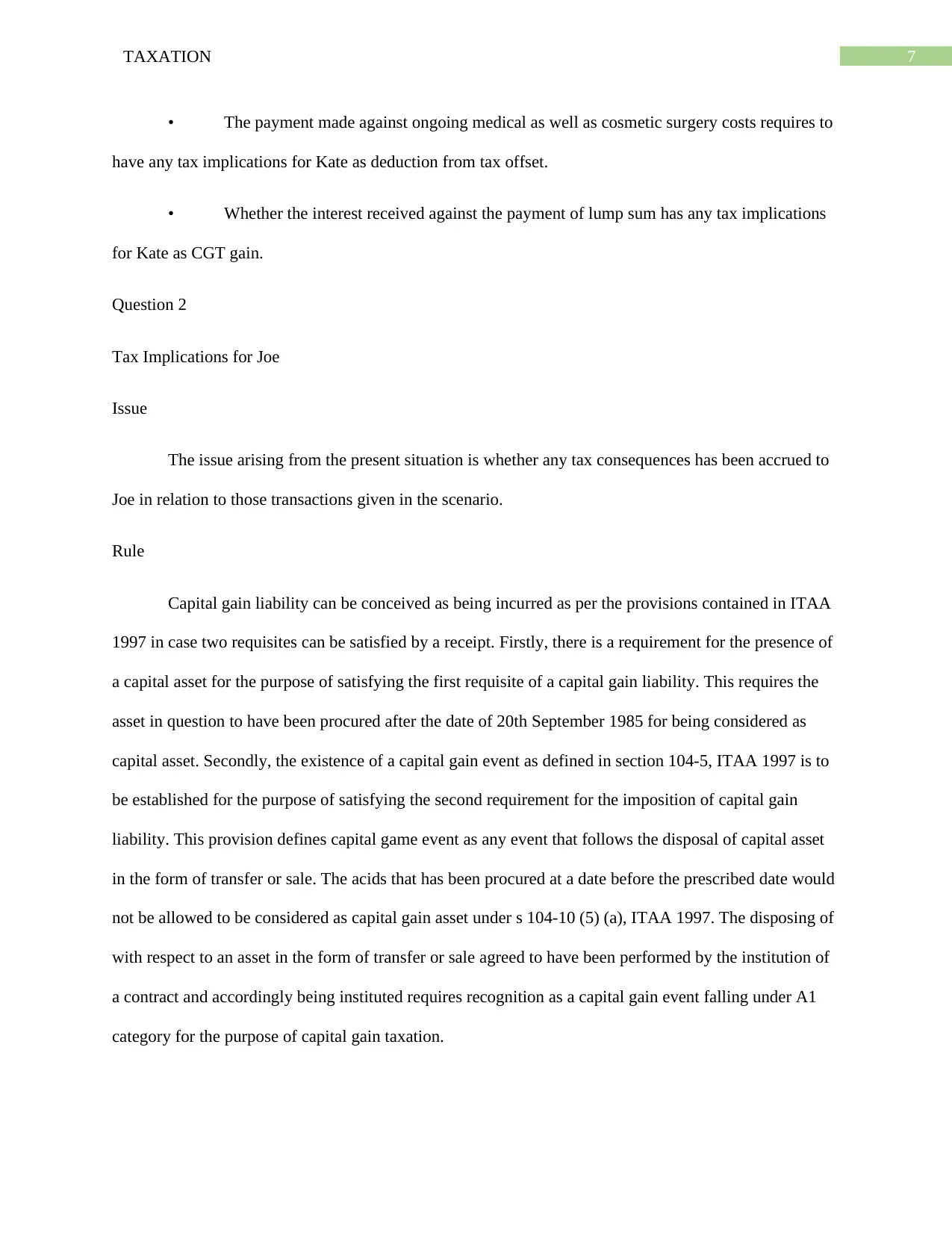
7TAXATION
• The payment made against ongoing medical as well as cosmetic surgery costs requires to
have any tax implications for Kate as deduction from tax offset.
• Whether the interest received against the payment of lump sum has any tax implications
for Kate as CGT gain.
Question 2
Tax Implications for Joe
Issue
The issue arising from the present situation is whether any tax consequences has been accrued to
Joe in relation to those transactions given in the scenario.
Rule
Capital gain liability can be conceived as being incurred as per the provisions contained in ITAA
1997 in case two requisites can be satisfied by a receipt. Firstly, there is a requirement for the presence of
a capital asset for the purpose of satisfying the first requisite of a capital gain liability. This requires the
asset in question to have been procured after the date of 20th September 1985 for being considered as
capital asset. Secondly, the existence of a capital gain event as defined in section 104-5, ITAA 1997 is to
be established for the purpose of satisfying the second requirement for the imposition of capital gain
liability. This provision defines capital game event as any event that follows the disposal of capital asset
in the form of transfer or sale. The acids that has been procured at a date before the prescribed date would
not be allowed to be considered as capital gain asset under s 104-10 (5) (a), ITAA 1997. The disposing of
with respect to an asset in the form of transfer or sale agreed to have been performed by the institution of
a contract and accordingly being instituted requires recognition as a capital gain event falling under A1
category for the purpose of capital gain taxation.
• The payment made against ongoing medical as well as cosmetic surgery costs requires to
have any tax implications for Kate as deduction from tax offset.
• Whether the interest received against the payment of lump sum has any tax implications
for Kate as CGT gain.
Question 2
Tax Implications for Joe
Issue
The issue arising from the present situation is whether any tax consequences has been accrued to
Joe in relation to those transactions given in the scenario.
Rule
Capital gain liability can be conceived as being incurred as per the provisions contained in ITAA
1997 in case two requisites can be satisfied by a receipt. Firstly, there is a requirement for the presence of
a capital asset for the purpose of satisfying the first requisite of a capital gain liability. This requires the
asset in question to have been procured after the date of 20th September 1985 for being considered as
capital asset. Secondly, the existence of a capital gain event as defined in section 104-5, ITAA 1997 is to
be established for the purpose of satisfying the second requirement for the imposition of capital gain
liability. This provision defines capital game event as any event that follows the disposal of capital asset
in the form of transfer or sale. The acids that has been procured at a date before the prescribed date would
not be allowed to be considered as capital gain asset under s 104-10 (5) (a), ITAA 1997. The disposing of
with respect to an asset in the form of transfer or sale agreed to have been performed by the institution of
a contract and accordingly being instituted requires recognition as a capital gain event falling under A1
category for the purpose of capital gain taxation.
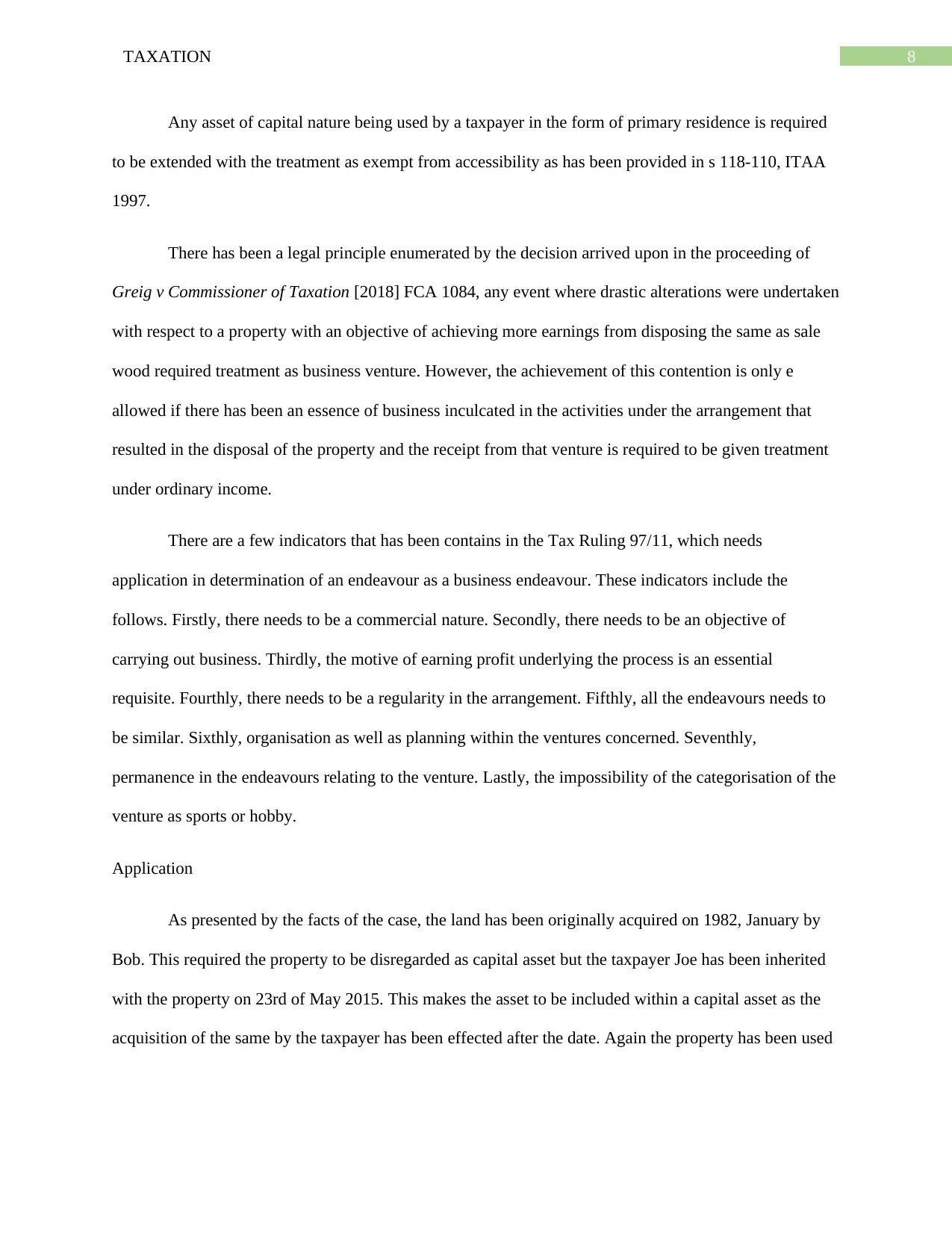
8TAXATION
Any asset of capital nature being used by a taxpayer in the form of primary residence is required
to be extended with the treatment as exempt from accessibility as has been provided in s 118-110, ITAA
1997.
There has been a legal principle enumerated by the decision arrived upon in the proceeding of
Greig v Commissioner of Taxation [2018] FCA 1084, any event where drastic alterations were undertaken
with respect to a property with an objective of achieving more earnings from disposing the same as sale
wood required treatment as business venture. However, the achievement of this contention is only e
allowed if there has been an essence of business inculcated in the activities under the arrangement that
resulted in the disposal of the property and the receipt from that venture is required to be given treatment
under ordinary income.
There are a few indicators that has been contains in the Tax Ruling 97/11, which needs
application in determination of an endeavour as a business endeavour. These indicators include the
follows. Firstly, there needs to be a commercial nature. Secondly, there needs to be an objective of
carrying out business. Thirdly, the motive of earning profit underlying the process is an essential
requisite. Fourthly, there needs to be a regularity in the arrangement. Fifthly, all the endeavours needs to
be similar. Sixthly, organisation as well as planning within the ventures concerned. Seventhly,
permanence in the endeavours relating to the venture. Lastly, the impossibility of the categorisation of the
venture as sports or hobby.
Application
As presented by the facts of the case, the land has been originally acquired on 1982, January by
Bob. This required the property to be disregarded as capital asset but the taxpayer Joe has been inherited
with the property on 23rd of May 2015. This makes the asset to be included within a capital asset as the
acquisition of the same by the taxpayer has been effected after the date. Again the property has been used
Any asset of capital nature being used by a taxpayer in the form of primary residence is required
to be extended with the treatment as exempt from accessibility as has been provided in s 118-110, ITAA
1997.
There has been a legal principle enumerated by the decision arrived upon in the proceeding of
Greig v Commissioner of Taxation [2018] FCA 1084, any event where drastic alterations were undertaken
with respect to a property with an objective of achieving more earnings from disposing the same as sale
wood required treatment as business venture. However, the achievement of this contention is only e
allowed if there has been an essence of business inculcated in the activities under the arrangement that
resulted in the disposal of the property and the receipt from that venture is required to be given treatment
under ordinary income.
There are a few indicators that has been contains in the Tax Ruling 97/11, which needs
application in determination of an endeavour as a business endeavour. These indicators include the
follows. Firstly, there needs to be a commercial nature. Secondly, there needs to be an objective of
carrying out business. Thirdly, the motive of earning profit underlying the process is an essential
requisite. Fourthly, there needs to be a regularity in the arrangement. Fifthly, all the endeavours needs to
be similar. Sixthly, organisation as well as planning within the ventures concerned. Seventhly,
permanence in the endeavours relating to the venture. Lastly, the impossibility of the categorisation of the
venture as sports or hobby.
Application
As presented by the facts of the case, the land has been originally acquired on 1982, January by
Bob. This required the property to be disregarded as capital asset but the taxpayer Joe has been inherited
with the property on 23rd of May 2015. This makes the asset to be included within a capital asset as the
acquisition of the same by the taxpayer has been effected after the date. Again the property has been used
⊘ This is a preview!⊘
Do you want full access?
Subscribe today to unlock all pages.

Trusted by 1+ million students worldwide
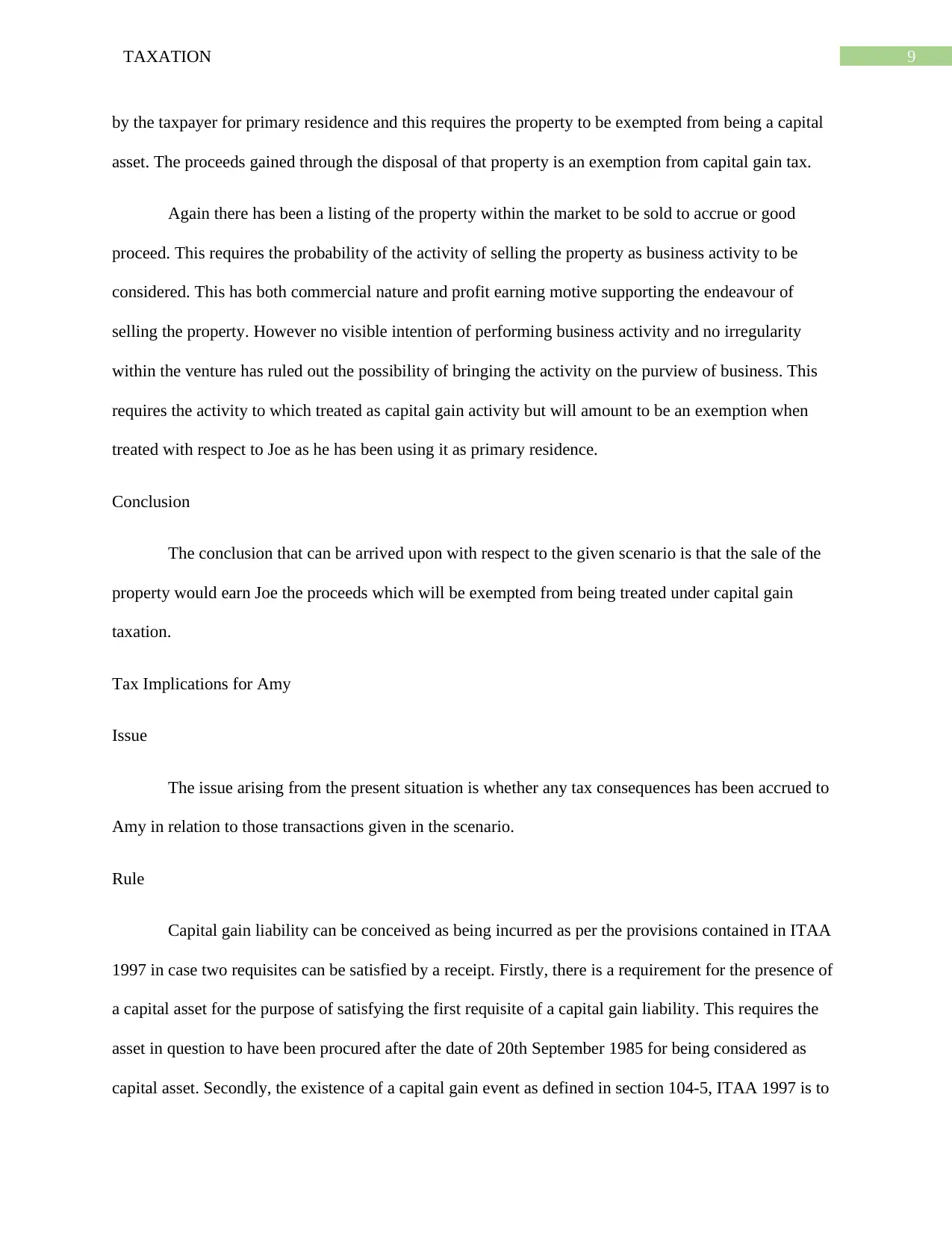
9TAXATION
by the taxpayer for primary residence and this requires the property to be exempted from being a capital
asset. The proceeds gained through the disposal of that property is an exemption from capital gain tax.
Again there has been a listing of the property within the market to be sold to accrue or good
proceed. This requires the probability of the activity of selling the property as business activity to be
considered. This has both commercial nature and profit earning motive supporting the endeavour of
selling the property. However no visible intention of performing business activity and no irregularity
within the venture has ruled out the possibility of bringing the activity on the purview of business. This
requires the activity to which treated as capital gain activity but will amount to be an exemption when
treated with respect to Joe as he has been using it as primary residence.
Conclusion
The conclusion that can be arrived upon with respect to the given scenario is that the sale of the
property would earn Joe the proceeds which will be exempted from being treated under capital gain
taxation.
Tax Implications for Amy
Issue
The issue arising from the present situation is whether any tax consequences has been accrued to
Amy in relation to those transactions given in the scenario.
Rule
Capital gain liability can be conceived as being incurred as per the provisions contained in ITAA
1997 in case two requisites can be satisfied by a receipt. Firstly, there is a requirement for the presence of
a capital asset for the purpose of satisfying the first requisite of a capital gain liability. This requires the
asset in question to have been procured after the date of 20th September 1985 for being considered as
capital asset. Secondly, the existence of a capital gain event as defined in section 104-5, ITAA 1997 is to
by the taxpayer for primary residence and this requires the property to be exempted from being a capital
asset. The proceeds gained through the disposal of that property is an exemption from capital gain tax.
Again there has been a listing of the property within the market to be sold to accrue or good
proceed. This requires the probability of the activity of selling the property as business activity to be
considered. This has both commercial nature and profit earning motive supporting the endeavour of
selling the property. However no visible intention of performing business activity and no irregularity
within the venture has ruled out the possibility of bringing the activity on the purview of business. This
requires the activity to which treated as capital gain activity but will amount to be an exemption when
treated with respect to Joe as he has been using it as primary residence.
Conclusion
The conclusion that can be arrived upon with respect to the given scenario is that the sale of the
property would earn Joe the proceeds which will be exempted from being treated under capital gain
taxation.
Tax Implications for Amy
Issue
The issue arising from the present situation is whether any tax consequences has been accrued to
Amy in relation to those transactions given in the scenario.
Rule
Capital gain liability can be conceived as being incurred as per the provisions contained in ITAA
1997 in case two requisites can be satisfied by a receipt. Firstly, there is a requirement for the presence of
a capital asset for the purpose of satisfying the first requisite of a capital gain liability. This requires the
asset in question to have been procured after the date of 20th September 1985 for being considered as
capital asset. Secondly, the existence of a capital gain event as defined in section 104-5, ITAA 1997 is to
Paraphrase This Document
Need a fresh take? Get an instant paraphrase of this document with our AI Paraphraser
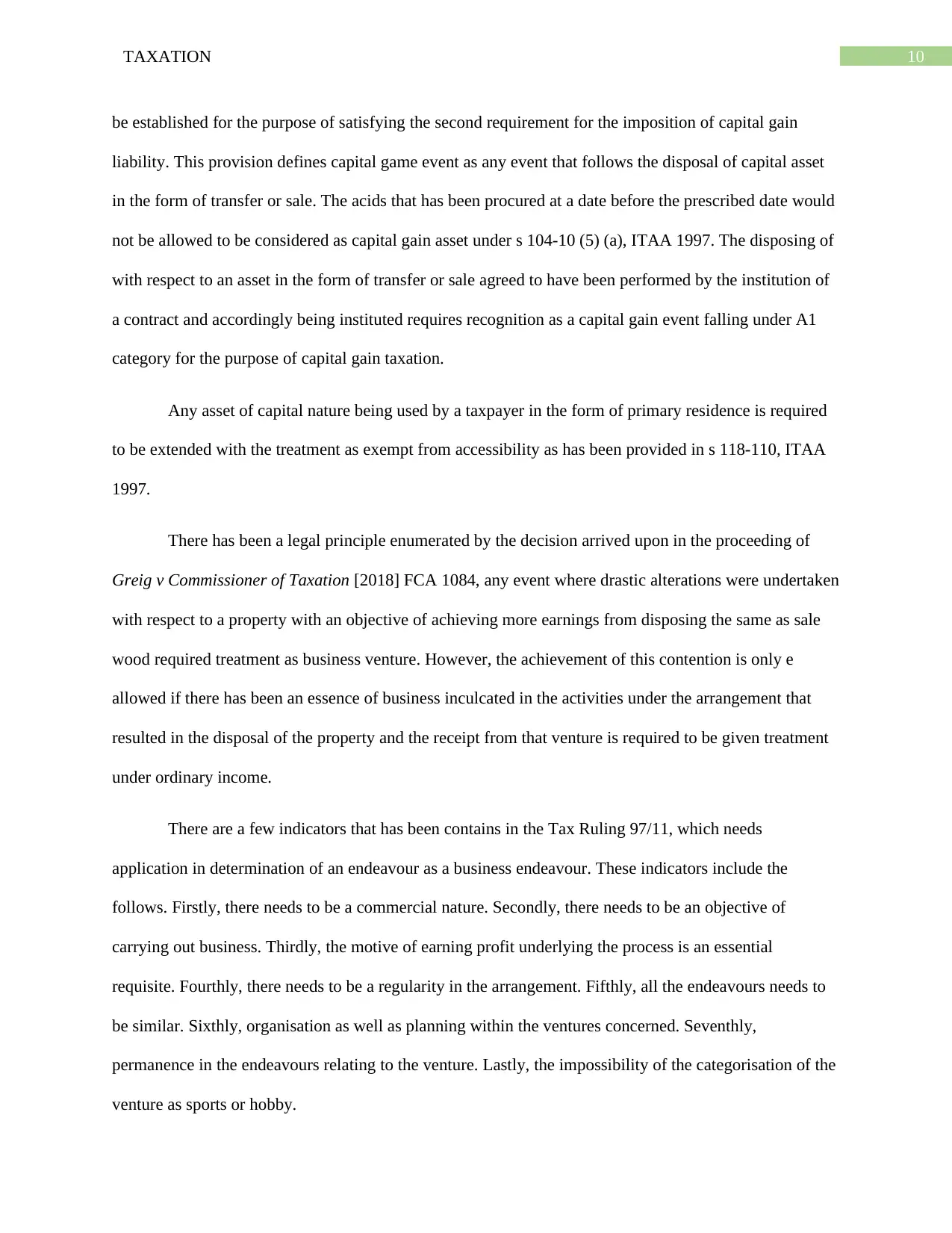
10TAXATION
be established for the purpose of satisfying the second requirement for the imposition of capital gain
liability. This provision defines capital game event as any event that follows the disposal of capital asset
in the form of transfer or sale. The acids that has been procured at a date before the prescribed date would
not be allowed to be considered as capital gain asset under s 104-10 (5) (a), ITAA 1997. The disposing of
with respect to an asset in the form of transfer or sale agreed to have been performed by the institution of
a contract and accordingly being instituted requires recognition as a capital gain event falling under A1
category for the purpose of capital gain taxation.
Any asset of capital nature being used by a taxpayer in the form of primary residence is required
to be extended with the treatment as exempt from accessibility as has been provided in s 118-110, ITAA
1997.
There has been a legal principle enumerated by the decision arrived upon in the proceeding of
Greig v Commissioner of Taxation [2018] FCA 1084, any event where drastic alterations were undertaken
with respect to a property with an objective of achieving more earnings from disposing the same as sale
wood required treatment as business venture. However, the achievement of this contention is only e
allowed if there has been an essence of business inculcated in the activities under the arrangement that
resulted in the disposal of the property and the receipt from that venture is required to be given treatment
under ordinary income.
There are a few indicators that has been contains in the Tax Ruling 97/11, which needs
application in determination of an endeavour as a business endeavour. These indicators include the
follows. Firstly, there needs to be a commercial nature. Secondly, there needs to be an objective of
carrying out business. Thirdly, the motive of earning profit underlying the process is an essential
requisite. Fourthly, there needs to be a regularity in the arrangement. Fifthly, all the endeavours needs to
be similar. Sixthly, organisation as well as planning within the ventures concerned. Seventhly,
permanence in the endeavours relating to the venture. Lastly, the impossibility of the categorisation of the
venture as sports or hobby.
be established for the purpose of satisfying the second requirement for the imposition of capital gain
liability. This provision defines capital game event as any event that follows the disposal of capital asset
in the form of transfer or sale. The acids that has been procured at a date before the prescribed date would
not be allowed to be considered as capital gain asset under s 104-10 (5) (a), ITAA 1997. The disposing of
with respect to an asset in the form of transfer or sale agreed to have been performed by the institution of
a contract and accordingly being instituted requires recognition as a capital gain event falling under A1
category for the purpose of capital gain taxation.
Any asset of capital nature being used by a taxpayer in the form of primary residence is required
to be extended with the treatment as exempt from accessibility as has been provided in s 118-110, ITAA
1997.
There has been a legal principle enumerated by the decision arrived upon in the proceeding of
Greig v Commissioner of Taxation [2018] FCA 1084, any event where drastic alterations were undertaken
with respect to a property with an objective of achieving more earnings from disposing the same as sale
wood required treatment as business venture. However, the achievement of this contention is only e
allowed if there has been an essence of business inculcated in the activities under the arrangement that
resulted in the disposal of the property and the receipt from that venture is required to be given treatment
under ordinary income.
There are a few indicators that has been contains in the Tax Ruling 97/11, which needs
application in determination of an endeavour as a business endeavour. These indicators include the
follows. Firstly, there needs to be a commercial nature. Secondly, there needs to be an objective of
carrying out business. Thirdly, the motive of earning profit underlying the process is an essential
requisite. Fourthly, there needs to be a regularity in the arrangement. Fifthly, all the endeavours needs to
be similar. Sixthly, organisation as well as planning within the ventures concerned. Seventhly,
permanence in the endeavours relating to the venture. Lastly, the impossibility of the categorisation of the
venture as sports or hobby.
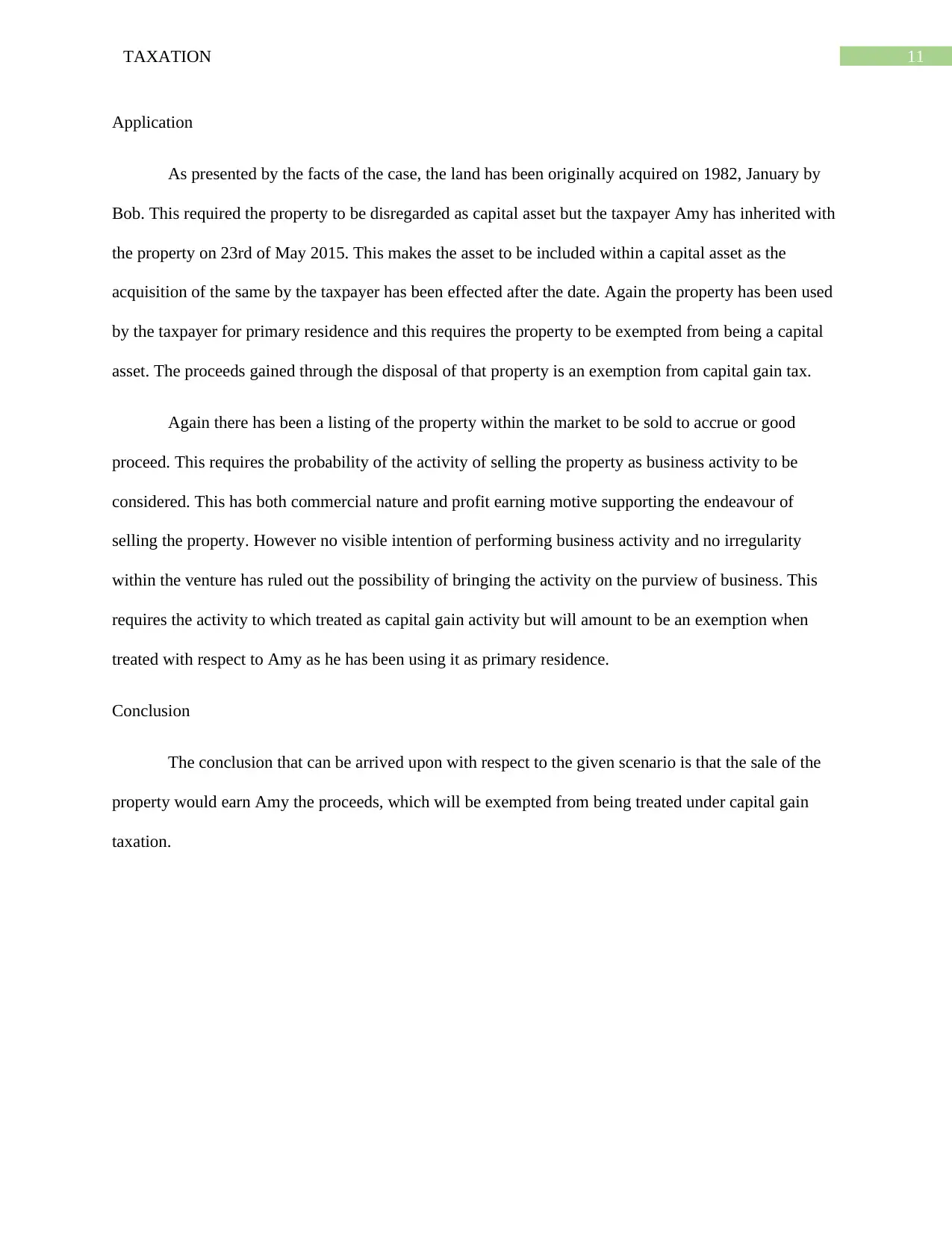
11TAXATION
Application
As presented by the facts of the case, the land has been originally acquired on 1982, January by
Bob. This required the property to be disregarded as capital asset but the taxpayer Amy has inherited with
the property on 23rd of May 2015. This makes the asset to be included within a capital asset as the
acquisition of the same by the taxpayer has been effected after the date. Again the property has been used
by the taxpayer for primary residence and this requires the property to be exempted from being a capital
asset. The proceeds gained through the disposal of that property is an exemption from capital gain tax.
Again there has been a listing of the property within the market to be sold to accrue or good
proceed. This requires the probability of the activity of selling the property as business activity to be
considered. This has both commercial nature and profit earning motive supporting the endeavour of
selling the property. However no visible intention of performing business activity and no irregularity
within the venture has ruled out the possibility of bringing the activity on the purview of business. This
requires the activity to which treated as capital gain activity but will amount to be an exemption when
treated with respect to Amy as he has been using it as primary residence.
Conclusion
The conclusion that can be arrived upon with respect to the given scenario is that the sale of the
property would earn Amy the proceeds, which will be exempted from being treated under capital gain
taxation.
Application
As presented by the facts of the case, the land has been originally acquired on 1982, January by
Bob. This required the property to be disregarded as capital asset but the taxpayer Amy has inherited with
the property on 23rd of May 2015. This makes the asset to be included within a capital asset as the
acquisition of the same by the taxpayer has been effected after the date. Again the property has been used
by the taxpayer for primary residence and this requires the property to be exempted from being a capital
asset. The proceeds gained through the disposal of that property is an exemption from capital gain tax.
Again there has been a listing of the property within the market to be sold to accrue or good
proceed. This requires the probability of the activity of selling the property as business activity to be
considered. This has both commercial nature and profit earning motive supporting the endeavour of
selling the property. However no visible intention of performing business activity and no irregularity
within the venture has ruled out the possibility of bringing the activity on the purview of business. This
requires the activity to which treated as capital gain activity but will amount to be an exemption when
treated with respect to Amy as he has been using it as primary residence.
Conclusion
The conclusion that can be arrived upon with respect to the given scenario is that the sale of the
property would earn Amy the proceeds, which will be exempted from being treated under capital gain
taxation.
⊘ This is a preview!⊘
Do you want full access?
Subscribe today to unlock all pages.

Trusted by 1+ million students worldwide
1 out of 13
Related Documents
Your All-in-One AI-Powered Toolkit for Academic Success.
+13062052269
info@desklib.com
Available 24*7 on WhatsApp / Email
![[object Object]](/_next/static/media/star-bottom.7253800d.svg)
Unlock your academic potential
Copyright © 2020–2025 A2Z Services. All Rights Reserved. Developed and managed by ZUCOL.





